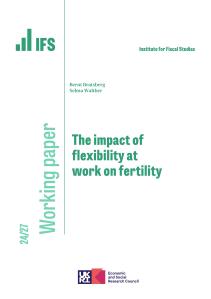Covid-19 has led to sharp falls in labour demand in many sectors of the economy and to acute labour shortages in other sectors. Much more than in a typical downturn, the current crisis is not simply a general slowdown in economic activity but also a radical, but temporary, shift in the mix of economic activities. The policy response so far has focused on cushioning the blow to families’ finances and allowing workers to return to their original jobs once the crisis subsides. These are crucial priorities. But there should also be a focus on temporarily reallocating some workers in temporarily shut down sectors to those facing labour shortages - removing barriers to taking up temporary jobs, facilitating worker loans between firms and sectors, and subsidising retraining where appropriate.
A temporary, radical restructuring of the economy
The public health response to Covid-19 has led to sharp falls in labour demand in many sectors. Non-essential retail, hospitality and leisure businesses have been ordered to close down, and air travel has largely halted due to travel restrictions. These sectors alone employed over 5 million workers in the UK on the eve of the crisis, and many will be left without work over the coming months. Add in the knock-on effects of these closures on other industries in those sectors’ supply chains, and the proportion of the UK workforce left without productive work to do is at risk of rising with unprecedented sharpness.
At the same time, we are seeing significant labour shortages in other sectors. Supermarkets, warehousing and delivery services and the NHS have launched recruitment drives to cope with the coronavirus spike. As the virus spreads further through the workforce, there is the potential for additional shortages in other sectors including, for example, “mission-critical” sectors like energy or water.
Hence, to a far greater extent than in a typical downturn, the current crisis is not simply a general slowdown in economic activity but also a radical (but temporary) shift in the mix of economic activities. This points towards the need not only to find ways of cushioning the blow to families’ finances for workers being furloughed or losing their jobs, but also for an urgent reallocation of some of these workers to other sectors (which can indeed also be a way of cushioning the blow to their finances).
However, much or all of this change in the mix of economic activity is going to be temporary and to be unwound once the crisis subsides. It is certainly possible that some habits, preferences and technologies are permanently affected by the crisis – maybe some fraction of those now turning to online deliveries will discover they like it and will continue doing it. But cafes and restaurants will reopen, air travel will resume, and people will start visiting shops again. In this respect the economy after Covid-19 will look more similar to how it looked before the virus came to our shores than to how it looks now.
The clear need to temporarily reallocate some workers must therefore be balanced with the need to have the economy ready to quickly resume ‘business as usual’ once the crisis is over.
Achieving that balance is not straightforward. If existing employment ties are broken now as furloughed workers find temporary employment elsewhere, the economy may be in a less good position to bounce back once the health crisis has passed. Recent research[1] has highlighted the importance of “firm-specific human capital” for workers – knowledge about the company’s operation and colleagues, for example, or proficiency in just the right combination of skills for the job, which means that they are able to work more productively (and hence potentially earn more) at their current firm than if they were to work somewhere else. The destruction of this ‘matching capital’ in recessions, as employment links get severed in the downturn, has been shown to derail workers’ careers, keep wages low and further dampen aggregate demand in the economy, propagating and prolonging the effects of the downturn.[2] Moreover, even if after the crisis all workers are able to find a firm that is as well matched to them as the firm they worked for pre-crisis, the one-off cost of the massive round of re-hiring that would need to take place as the public health crisis passes would itself be significant.
The policy response so far: trying to limit permanent job separations
The initial policy response has been focused heavily on preventing employment ties from being severed in struggling sectors (essentially, encouraging what economists call “labour hoarding”) and protecting the incomes of those workers. The government has moved to extend loans and cash grants to firms in badly hit sectors, and subsidise up to 80% of wages for furloughed workers through the Coronavirus Job Retention Scheme (JRS). These policies insure firms against the shock, making it more likely that they will hang onto their workers through the pandemic (and their capital – something we focus on less in this note, but which is also very important) so that business can be speedily and efficiently resumed post-crisis. The JRS in particular also insures workers against falls in income, so they can continue to meet their housing costs and other spending commitments.
This approach is fairly well designed as an attempt to preserve the ‘matching capital’ described above, allowing workers to resume working in their original job once the crisis has passed. Further tweaks might still finesse it in this respect: for example, the JRS encourages firms to furlough some workers completely (to get the subsidy) rather than to reduce hours more marginally for a larger share of workers. Perhaps more fundamentally, though, it does not address the other need we have discussed here, which is for some temporary re-allocation of workers to sectors with labour shortages. This need for temporary re-allocation is worth prioritising too. These sectors are critical to preventing deaths and safeguarding food supply, so the consequences of them being under-resourced could be very serious. The existence of so many furloughed workers provides an obvious source of a solution to this problem.
Can policy also facilitate temporary reallocation of workers?
The ideal outcome in this scenario would be twofold: to find a way of reallocating some workers in temporarily shut down sectors to those sectors facing temporary labour shortages, whilst still allowing them to return seamlessly to their original work once the crisis is over.
How might we achieve this in practice?
An obvious start is to highlight opportunities in sectors facing labour shortages in each local area. This could be done through a freelancing platform, in the style of TaskRabbit or UpWork, which the government could advertise to furloughed workers. To encourage (or at least not discourage) furloughed workers to take up opportunities, the government should clarify and emphasise that the JRS is available to those who take up temporary jobs with a different employer.
Going a step further, we could identify the skills needed to perform jobs for which there are labour shortages, and identify occupations in low-demand sectors that correspond to these skills. This is already happening in a piecemeal way. For example, laid-off cabin crew at SAS have been offered fast-tracked healthcare training in Sweden; a good match since cabin crew are already trained in first-aid and following emergency procedures. Other such sensible matches between occupations are likely to exist. The government could connect employers in labour shortage sectors with workers or firms in furloughed sectors – for example by putting out a call for proposals for firms or professional bodies to fill available roles – and perhaps subsidise any retraining of workers required. This is potentially a substantial task in coordination, though perhaps aided by the fact that a relatively small number of large employers will often account for a large share of the labour shortages in an area (for example, the big supermarkets).
The government might choose to take a more heavy-handed approach, for example by making the JRS conditional on taking up a job in a labour shortage sector if one is available locally. But there are likely to be big challenges with that in practice. First, not all local areas will have large labour shortages relative to furloughed jobs. For example, London has many cafés and restaurants but few warehouses, whereas the opposite is true in rural areas. This means that the share of furloughed workers who would be required to take up additional work may vary widely across areas, which could be seen as unfair.
Second, jobs for which there are labour shortages will often require leaving the home and being exposed to the virus. This will not be feasible or desirable for older workers, those with underlying health conditions or those who live with or care for medically vulnerable people. Establishing who would be exempt from conditionality could be a complex process that is difficult to get right at the best of times, let alone in such a short timeframe.
Whatever is the best way of enabling furloughed workers to temporarily take up work in other sectors, a crucial challenge while doing this is to make sure that existing employer-employee links are not permanently severed - so that we do not need a massive rehiring and reallocation exercise just to return to where we were before once the crisis ends.
Conclusion
The nature of the economic shock associated with Covid-19 is highly unusual. Not only is the scale of the downturn likely to be large; the types of economic activity that we are doing in the UK have changed radically in a matter of days. But the vast majority of that change is likely to be temporary, and we will want to keep the economy ready to return to ‘business as usual’ as seamlessly as possible once the crisis subsides. This creates a distinctive set of labour market policy challenges.
The following is clear: the policy response should preserve existing employer-worker links by limiting permanent job separations, all while removing barriers to taking up temporary stopgap jobs. The government should clarify - and emphasise - that the JRS is still available to workers who take up stopgap work in priority sectors. The government could also actively coordinate worker loans between firms and sectors, and subsidise retraining where appropriate.
We have set out some of the issues here. Further work at IFS will be aiming to quantify some of the issues set out, and to make further progress in identifying how policy should proceed.
[1] Fujita and Moscarini (2017), Jacobson, Lalonde and Sullivan (1993), Davis and von Wachter 2011
[2] Moscarini and Postel-Vinay (2016, 2019)












